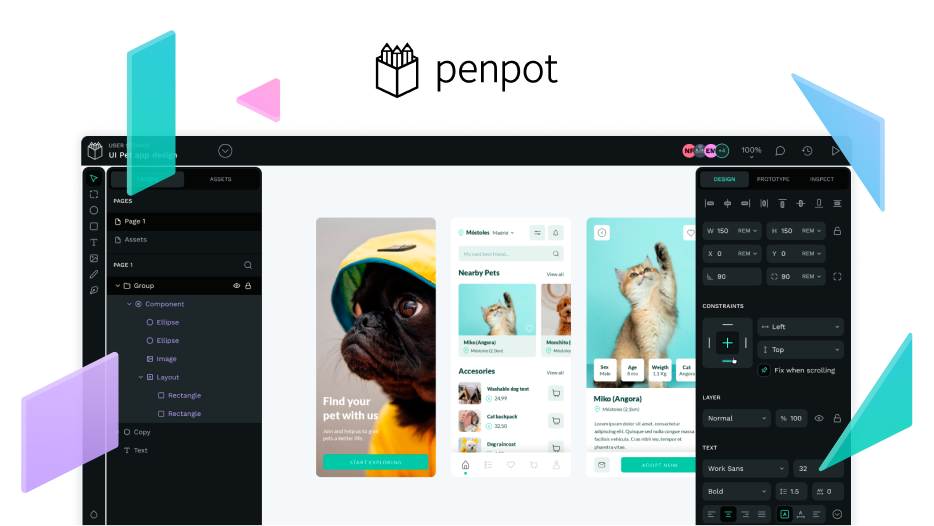Community member @prononext has shared their needs for anonymous comments (no need for a Penpot account) for shared prototypes. I quote from their feature request.
By implementing this feature, we can create a more meaningful and productive conversation with our customers and enhance the overall effectiveness of our design process. The customer communication is where the success lies, and this new feature will take it to the next level.
Similar requests are commonplace for other collaborative design tools and yet it’s hard to see this at work. Why is that? I can’t speak for other tools but I can share some of the rationale behind tagging this type of requests as “not a priority”.
The opinionated “why not”
Penpot’s aim is to go beyond existing broken feedback workflows. Stakeholders (aka clients) don’t feel they belong to the design process because it’s a terrible experience every time they try to use the design tool to provide feedback. I’ll share a fun story as an example.
A few weeks ago I was having dinner at a nice restaurant in Palo Alto (California) before flying back to Spain and I ended up having a conversation with a perfect stranger sitting next to me at the bar. It turns out this perfect stranger was a super senior executive at a tech megacorp who became quite excited about Penpot and our ambition to be truly inclusive for all stakeholders. He would look me in the eyes and would almost yell "I hate F***! I really really hate that tool! Why is everything so tiny? I can’t use it properly! I can’t give feedback or review the work of my design team! It’s a mess! It’s horrible! I need an alternative! Please, please, be that alternative!"*
Most probably this passionate executive was suffering from a dysfunctional feedback workflow. Who knows? Perhaps he was even in the need of guest commenting!
However, the root of the problem here was that he never felt he was part of the design process, at best he’d a “guest” from time to time. The tool had no convincing way to prove to him he was a “power user” or VIP.
At Penpot we would like to make it obvious to those stakeholders that there’s a ton of value for them in having a fruitful conversation within the tool. This means a great onboarding experience but also a clear incentive-driven set of features. In other words, we would rather redefine that experience rather than “patch” it. It actually takes much more work, but the ROI feels much larger!
The technical “why not”
Anonymous or guest commenting is a risky business. It can be done but it’s a never-ending whack-a-mole game. One of the biggest risks is that you can’t easily enforce terms of service for anonymous users, so you might have to point at the project owner as the ultimate responsible of what was edited or added as “anonymous”. People always think of the happy paths for a specific feature but as a product team we need to consider all the ways this could be maliciously exploited (spam, storage, phishing, intrusion attacks, etc).
There are various ways to implement this. You might want to have a hardcoded platform-wide “guest” user that is legally impersonated by any number of sessions. Effectively, you’d have a password-less user. You could also create a new password-less guest-user on the spot (Google docs probably uses this technique) just for that session. In both cases, you need to keep all this data persistent.
Since password-less guest users can’t self-identify, you need to ask for some metadata (give me your name!) before allowing to post (or else, it’s a different type of mess), thus causing a bit of friction every time the stakeholder wants to give feedback and quickly ending up in one person using different ways to refer to themselves. I might start with Pablo Ruiz-Múzquiz but then use “P” or “@diacritica” depending on my mood each time.

Mockup by outstanding community member @prononext where they show required fields wizard
As a designer, you’d love to comment back and continue that thread within the tool but there’s no way Penpot can notify such activity by email/app to the stakeholder (unless you ask for an email address, at which point this starts to dangerously look like multiples logins while also increasing spam/phishing attacks incentive!).
There are valid tech workarounds for every single issue, but we would prefer to work on a better solution altogether and test that before investing resources in this potential rabbit hole.
I hope I made clear that stakeholder feedback is critical to Penpot. We’re considering different ways to make Penpot really accessible and valuable to all stakeholders, not only designers. You can look at what we’re doing for developers, for instance. Features like Flex Layout bring developers into the tool, willingly! Similarly, we’re looking forward to finding ways to make Penpot a wonderful experience for all product stakeholders.
I would like to thank @prononext and other community members for their thoughtful requests. We get so much valuable feedback (I mean, look at their github issue, that’s the way!). I also want to apologize if we sometimes have to say “not yet” or “not exactly that way”!
